Diet and blood pressure: seeking answers
Our lab is dedicated to seeking answers to ongoing questions about human hypertension and kidney disease.
We are also committed to sharing our techniques openly with fellow researchers and cultivating a larger community of transparency and research integrity.
Our current projects determine:

- How potassium prevents hypertension
- How the kidney senses potassium
- How gene mutations cause hypertension
- How aldosterone damages the heart and kidney
Pictured left: our findings on the effect of potassium on NaCl transporter abundance. Read more about them in Potassium Modulates Electrolyte Balance and Blood Pressure through Effects on Distal Cell Voltage and Chloride by Terker et al.
Recent Achievements

Medical Society of Metropolitan Portland Student Award
Recent alumni of the lab and current medical student, Elizabeth Swanson, has been honored by the annual student award from the Medical Society of Metropolitan Portland. Read more about the honor in The Scribe, a publication of the Medical Society of Metropolitan Portland.
Experimental Biology Posters and Professors Finalist (pictured left)
Ryan Cornelius, Ph.D. was a finalist for the Posters and Professors awards session and represented our lab at the Experimental Biology conference.
Medical Research Foundation Discovery Award recipient
David H. Ellison, M.D. received the Discovery Award for his innovative contributions to nephrology and hypertension research in Oregon. Read more about this prestigious award in the OHSU blog article, Medical Research Foundation honors top Oregon scientists, mentors
Getting a closer look at the kidney

By investing time in thinking creatively about developing new techniques, we can extend the depth of our findings
Pictured right: preliminary 3D rendering from immunofluorescence and clearing studies, showing mouse renal medulla tubules in striking clarity by tracking the protein aquaporin 2 (AQP2) in green.